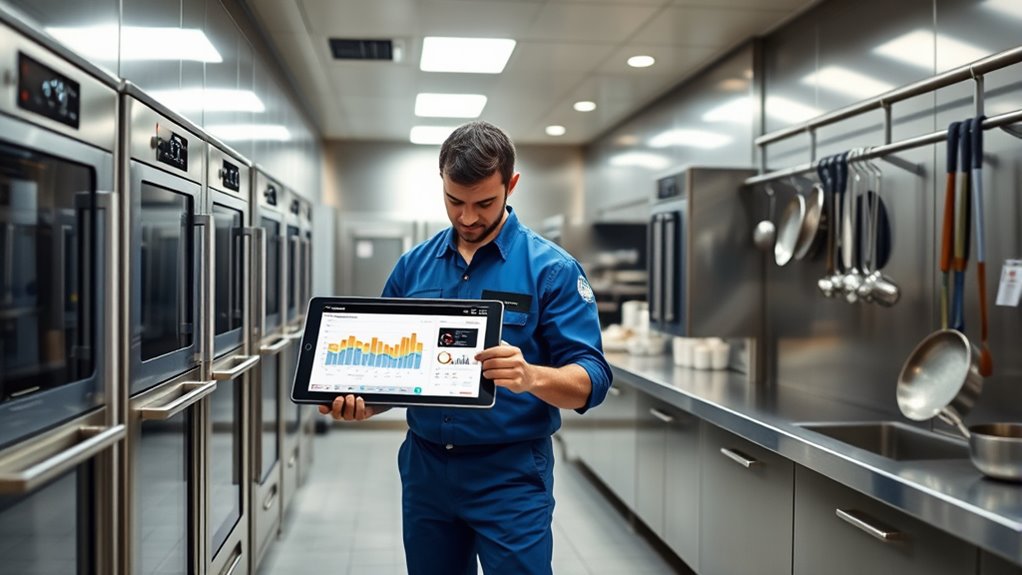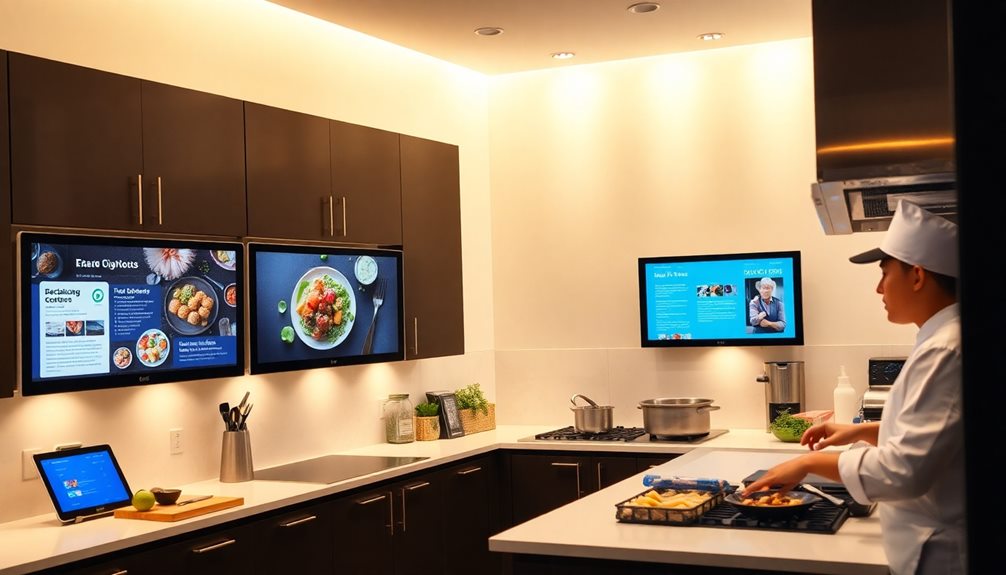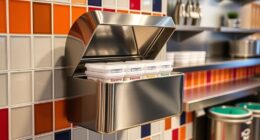Predictive maintenance for kitchen equipment uses sensors and real-time data to monitor performance, helping you identify issues before failures happen. By analyzing parameters like temperature, vibration, and cycles, you can schedule repairs proactively, reducing downtime and extending the lifespan of your appliances. Implementing this technology keeps your kitchen running smoothly, saves costs, and enhances safety. If you keep exploring, you’ll discover how to set up and optimize these systems for your facility.
Key Takeaways
- Implement sensors to monitor temperature, vibration, and cycle counts for real-time equipment health insights.
- Analyze sensor data with cloud-based platforms and machine learning to detect early signs of wear or failure.
- Establish baseline performance metrics and use anomaly detection to schedule proactive maintenance.
- Integrate IoT devices and data management tools to streamline maintenance planning and reduce downtime.
- Adopt best practices like regular calibration, system updates, and staff training for effective predictive maintenance programs.
Understanding Predictive Maintenance in Commercial Kitchens
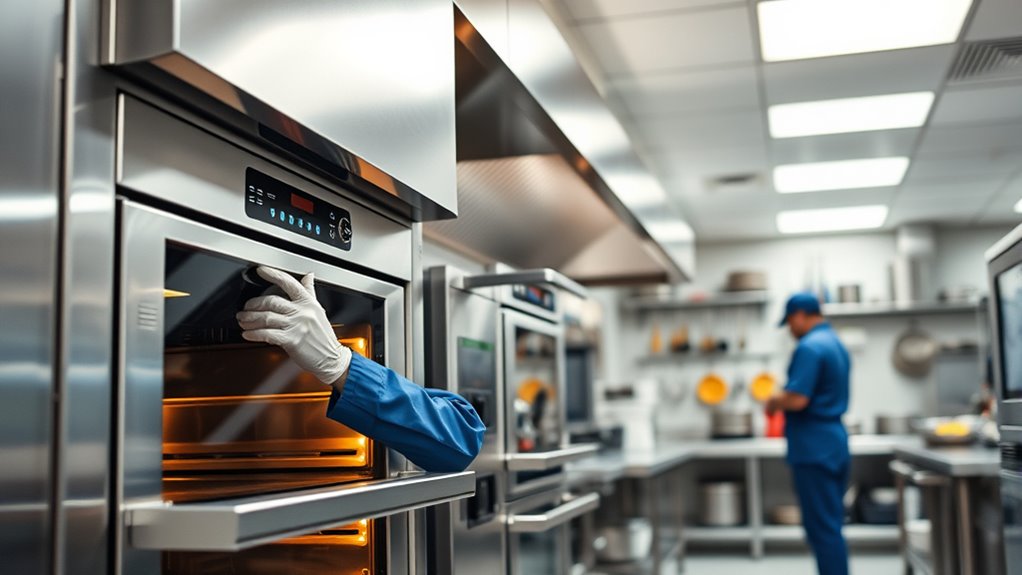
Predictive maintenance in commercial kitchens involves using data and sensor technology to monitor equipment performance and identify potential issues before they lead to failures. You install sensors on appliances like ovens, refrigerators, and dishwashers to collect real-time data on temperature, vibration, and operational cycles. This information is analyzed through specialized software that detects patterns indicating wear or malfunction. By continuously monitoring these parameters, you can predict when a piece of equipment might break down, allowing you to schedule repairs proactively. Regular maintenance checks and understanding equipment lifespan help further prevent unexpected failures. This approach minimizes unexpected downtime and extends equipment lifespan. Instead of waiting for breakdowns, you stay ahead of problems, ensuring your kitchen runs smoothly. Overall, predictive maintenance helps you optimize operations, reduce costs, and improve service quality.
Key Benefits of Implementing Predictive Strategies
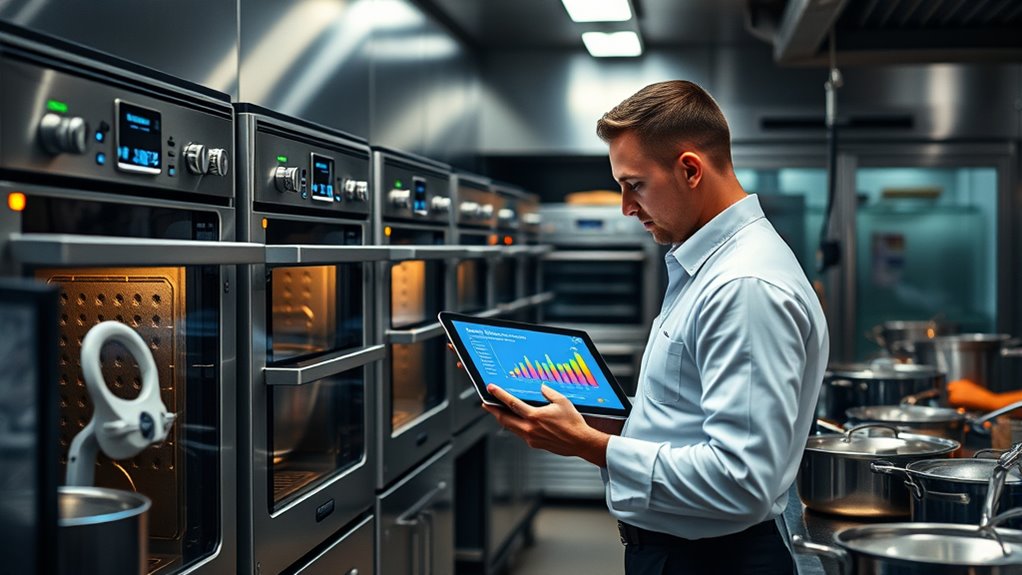
Implementing predictive strategies in your commercial kitchen offers a range of tangible benefits that can substantially enhance daily operations. You’ll experience fewer unexpected breakdowns, reducing downtime and maintaining a steady workflow. Maintenance becomes more targeted, saving you time and money by addressing issues before they escalate. This approach also extends the lifespan of your equipment, delaying costly replacements. Additionally, you’ll improve safety and hygiene standards, as well-maintained appliances operate more efficiently. Regular monitoring and data analysis can further optimize preventive maintenance efforts, ensuring issues are caught early. Here’s a quick overview:
| Benefit | Impact | Example |
|---|---|---|
| Reduced downtime | Keeps kitchen running smoothly | Less service interruptions |
| Cost savings | Less emergency repairs | Fewer urgent parts replacements |
| Equipment longevity | Longer lifespan | Better ROI on investments |
| Safety and hygiene | Fewer hazards | Cleaner, safer appliances |
| Operational efficiency | Faster, more reliable service | Increased customer satisfaction |
Essential Data Collection for Equipment Monitoring

To effectively monitor your kitchen equipment, collecting accurate and relevant data is essential. You need to identify key parameters that indicate equipment health, such as temperature, vibration, and cycle counts. Sensors and data loggers can help capture this information in real-time, providing a clear picture of performance. Focus on collecting data during normal operation to establish baseline readings, making it easier to spot anomalies. Keep in mind, quality over quantity matters—select data points that directly reflect equipment conditions rather than overwhelming yourself with unnecessary details. Consistent data collection allows you to track trends, predict failures, and schedule maintenance proactively. Additionally, leveraging specialized tuning techniques can optimize equipment performance and longevity. Ultimately, thorough and precise data gathering forms the foundation for effective predictive maintenance strategies, reducing downtime and extending equipment lifespan.
Technologies Powering Predictive Maintenance
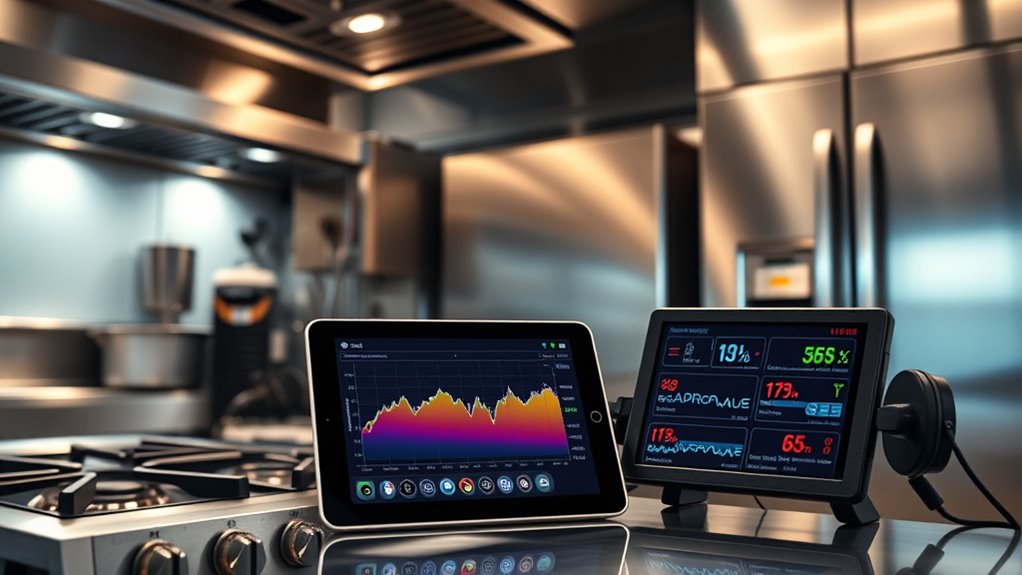
Advancements in technology have revolutionized how kitchen equipment maintenance is managed, making data-driven approaches more practical and effective. You now leverage sensors, IoT devices, and cloud computing to monitor equipment in real time. Sensors collect data on temperature, vibration, and usage patterns, while IoT connectivity ensures this information is transmitted instantly. Cloud platforms analyze the data, identifying patterns and detecting anomalies that indicate potential failures. Machine learning algorithms enhance predictive accuracy, enabling you to forecast issues before breakdowns occur. Additionally, mobile apps and dashboards give you immediate access to equipment health insights, helping you make informed maintenance decisions. These technologies work together to maximize equipment uptime, reduce costs, and improve overall kitchen efficiency. Incorporating predictive maintenance strategies further optimizes your operations by anticipating issues early and scheduling timely interventions.
Analyzing Equipment Performance and Health Indicators

You need to monitor key metrics like temperature, vibration, and cycle counts to assess equipment health. Spotting anomalies early allows you to address issues before they cause breakdowns. By accurately interpreting sensor data, you can keep your kitchen equipment running smoothly and efficiently. Incorporating predictive maintenance techniques from Kia Tuning, such as engine tuning and performance upgrades, can help optimize the overall performance and longevity of your equipment.
Monitoring Key Metrics
Monitoring key metrics is essential for evaluating the health and performance of kitchen equipment effectively. By tracking data such as temperature, vibration, cycle counts, and run times, you gain real-time insights into how your appliances are functioning. This allows you to identify signs of wear or inefficiency early, preventing costly breakdowns. Use sensors and data collection tools to gather accurate information consistently. Regularly review these metrics to establish baseline performance levels and spot deviations. Keeping an eye on key indicators helps you prioritize maintenance, optimize equipment lifespan, and ensure safety standards are met. Remember, precise observation provides the foundation for predictive maintenance strategies, reducing downtime and improving overall kitchen efficiency. Incorporating juice extraction data can also help monitor equipment performance related to beverage preparation.
Detecting Anomalies Early
Analyzing equipment performance and health indicators allows you to spot anomalies before they lead to costly failures. By regularly reviewing data such as temperature fluctuations, vibration patterns, and operational cycles, you can identify unusual behaviors early. For example, a sudden spike in motor vibration may signal bearing wear, while inconsistent temperature readings could indicate heating element issues. Recognizing these signs promptly enables you to schedule maintenance before a breakdown occurs. This proactive approach minimizes downtime and extends the lifespan of your kitchen equipment. Consistent monitoring helps you establish a baseline of normal operation, making deviations more apparent. Additionally, understanding Porsche Tuning techniques can inspire innovative ways to optimize equipment performance and reliability. Ultimately, early anomaly detection keeps your kitchen running smoothly, reduces repair costs, and ensures consistent food quality and safety.
Interpreting Sensor Data
How can sensor data reveal the true condition of your kitchen equipment? By analyzing real-time readings, you can identify patterns indicating normal operation or potential issues. For example, temperature fluctuations, vibration levels, or electrical currents can signal wear or impending failure. When you interpret these indicators correctly, you gain insights into equipment performance and health. Look for trends like rising temperatures or irregular vibration, which often precede breakdowns. Use data visualization tools to spot anomalies quickly. Regularly reviewing sensor data helps you understand your equipment’s baseline performance. This monitoring process allows for timely interventions before minor issues become major failures. This proactive approach enables you to schedule maintenance before costly failures occur, ensuring kitchen operations stay smooth. Mastering data interpretation empowers you to make informed decisions, extend equipment lifespan, and optimize maintenance routines.
Setting Up a Predictive Maintenance Program
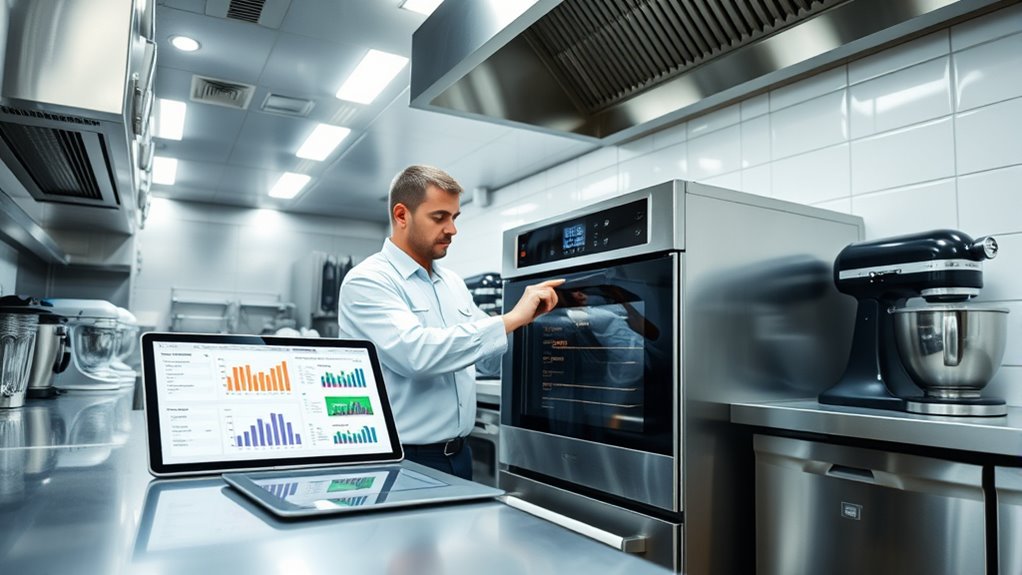
To establish an effective predictive maintenance program for your kitchen equipment, you need to start by evaluating your current operations and identifying critical assets. List out all major appliances and machinery, noting their age, usage frequency, and past maintenance history. Prioritize equipment that directly impacts food safety, service speed, or safety standards. Then, set clear goals for your program, such as reducing breakdowns or minimizing downtime. Invest in suitable sensors and monitoring tools tailored to your equipment, and confirm they’re properly installed. Develop a schedule for regular data collection and analysis, integrating this into your workflow. Training staff on sensor use and data interpretation is essential. By establishing these foundational steps, you’ll position your kitchen for proactive maintenance and improved efficiency.
Common Challenges and How to Overcome Them
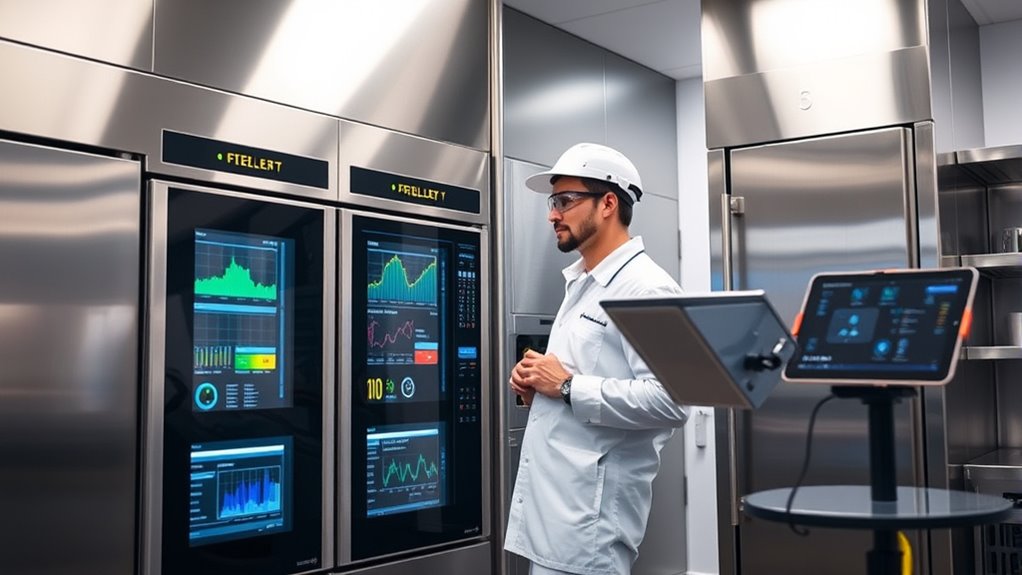
You might face challenges like integrating data from different systems, which can be complex and time-consuming. Sensor accuracy issues can lead to false alarms or missed problems, making maintenance less reliable. Gaps in scheduling maintenance can cause equipment failures, so it’s essential to develop a clear, consistent plan to address these issues. Implementing essential oil benefits in maintenance routines can also help improve overall system performance by reducing stress and promoting a balanced environment.
Data Integration Difficulties
Integrating data from diverse kitchen equipment can be a complex task, often hindered by incompatible systems and inconsistent data formats. You might encounter challenges syncing data from different brands or models that use varied protocols or lack standardization. Data silos can prevent a unified view of equipment health, making it harder to identify patterns or predict failures accurately. To overcome this, you should adopt middleware or data integration platforms that support multiple protocols and formats. Standardizing data collection methods and establishing clear data governance policies also help guarantee consistency. Regularly updating your integration tools and training staff on data management best practices can reduce errors. Embracing standardized data formats from the outset ensures smoother integration and more reliable predictive maintenance outcomes. By addressing these hurdles, you’ll improve data quality and create a reliable foundation for effective predictive maintenance.
Sensor Accuracy Issues
Sensor accuracy can pose significant challenges in predictive maintenance, especially when data from various kitchen equipment isn’t reliable. Inaccurate sensors can lead to false alarms or missed issues, risking equipment failure. To tackle this, you should:
- Regularly calibrate sensors to ensure precise readings.
- Use high-quality sensors suited for your specific kitchen environment.
- Implement validation routines to cross-check sensor data against manual inspections or alternative sources.
Maintenance Scheduling Gaps
One common challenge in predictive maintenance for kitchen equipment is the gap in maintenance scheduling, which can lead to unexpected breakdowns or unnecessary downtime. If you don’t schedule maintenance at ideal times, you risk equipment failure during busy hours or wasting resources on unnecessary repairs. To overcome this, implement data-driven scheduling that aligns with equipment usage patterns and predictive insights. Regularly review maintenance data and adjust schedules as needed. Use automated systems to alert you when maintenance is due, reducing reliance on manual planning. Clear communication with your team ensures everyone understands the importance of timely maintenance. By closing these scheduling gaps, you can enhance equipment reliability, improve efficiency, and minimize disruptions in your kitchen operations.
Case Studies: Success Stories in the Food Service Industry
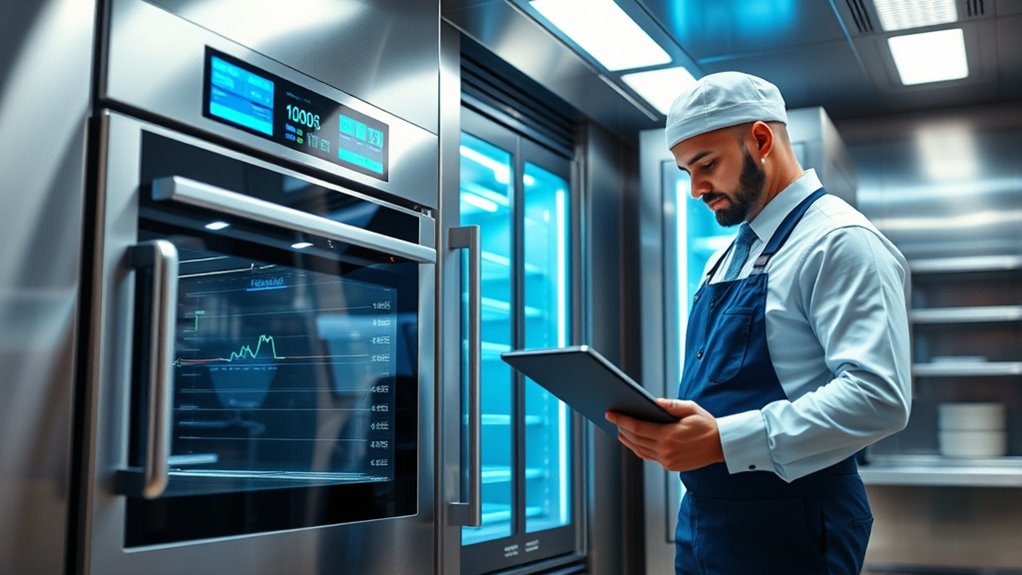
In the competitive world of food service, maintaining reliable kitchen equipment is essential for delivering consistent quality and customer satisfaction. Several businesses have successfully used predictive maintenance to reduce downtime and improve efficiency. For example, a major restaurant chain:
- Implemented sensors on their fryers, catching early signs of wear and preventing breakdowns.
- Used data analytics to schedule maintenance during off-peak hours, minimizing service disruptions.
- Achieved a 30% reduction in equipment failures within six months.
Another success story involves a bakery that used predictive analytics to monitor ovens, resulting in fewer emergency repairs and more consistent baking results. These case studies prove that investing in predictive maintenance can boost productivity, cut costs, and ensure your kitchen runs smoothly.
Best Practices for Maintaining and Updating Systems
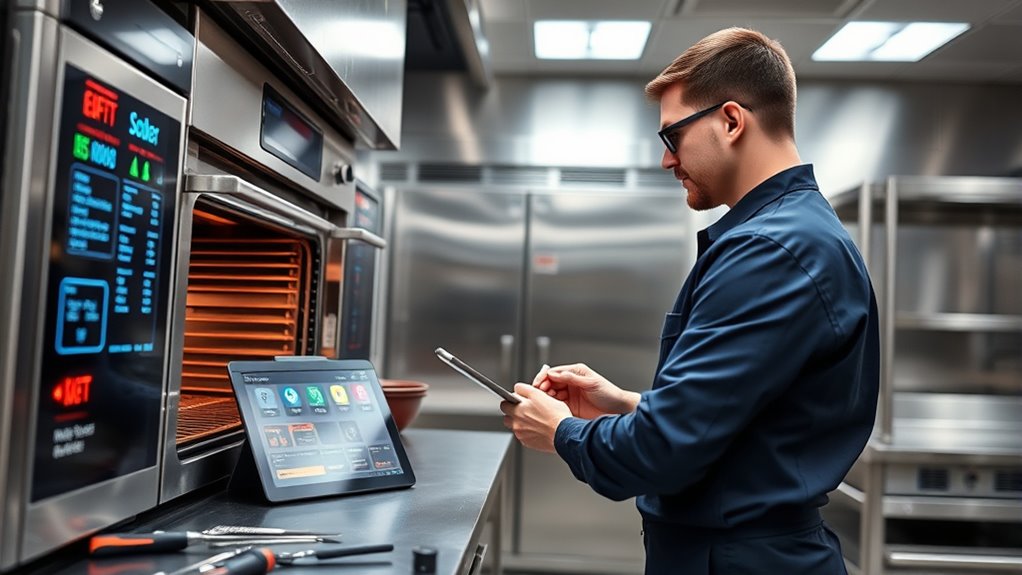
To keep your predictive maintenance systems effective, regular maintenance and timely updates are essential. Schedule routine inspections to identify and fix issues before they escalate. Keep software and firmware current, ensuring compatibility with new technologies and security protocols. Regularly review sensor calibration to maintain data accuracy. Create a maintenance log to track updates, repairs, and system performance. Train staff on system use and troubleshooting, so they can address minor issues promptly. Implement automated alerts for upcoming updates or potential failures. Collaborate with vendors to stay informed about software patches and hardware upgrades. Consistently evaluate system performance against key metrics, making adjustments as needed. Staying proactive with maintenance and updates helps maximize system uptime and extends equipment lifespan.
Future Trends in Kitchen Equipment Maintenance
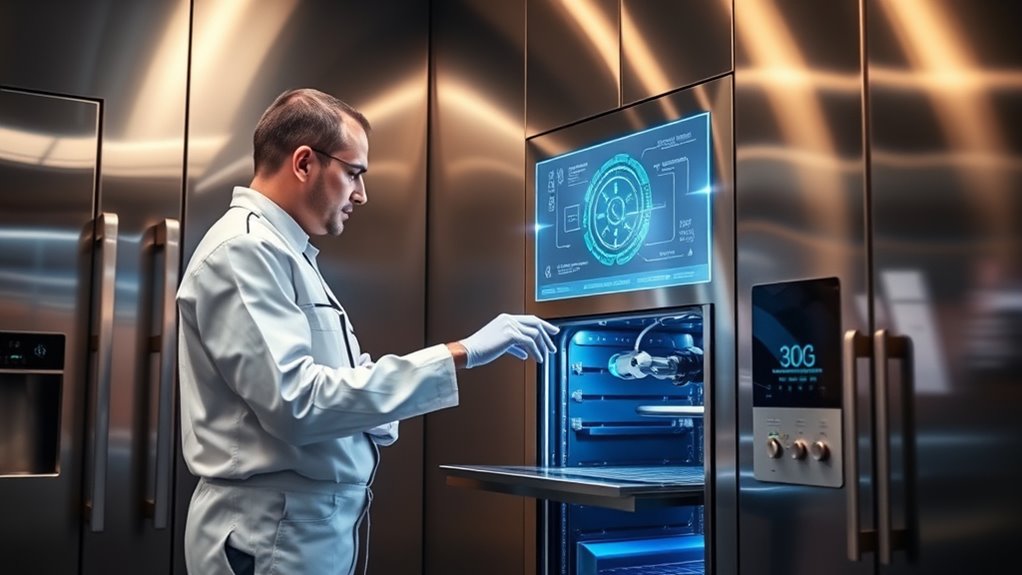
As technology continues to advance, the future of kitchen equipment maintenance is increasingly shaped by innovations like artificial intelligence, machine learning, and the Internet of Things (IoT). These technologies will enable you to guarantee problems before they happen, optimize maintenance schedules, and reduce downtime. Here are some key trends to watch:
- Smart Sensors: Devices will continuously monitor equipment health, providing real-time data that helps you act proactively.
- AI-Driven Analytics: Advanced algorithms will analyze data to identify patterns, predict failures, and recommend maintenance actions.
- Connected Ecosystems: IoT will create integrated systems that communicate seamlessly, streamlining your maintenance processes and improving efficiency.
Embracing these trends ensures your kitchen stays operational, safe, and cost-effective.
Frequently Asked Questions
How Much Does Implementing Predictive Maintenance Typically Cost?
You’re wondering about the cost of implementing predictive maintenance. Typically, it varies based on the size of your operation, the equipment involved, and the technology used. Expect to spend on sensors, software, and integration, which can range from a few thousand to tens of thousands of dollars initially. However, these costs often pay off through reduced downtime, fewer repairs, and increased efficiency over time.
Can Small Kitchens Benefit From Predictive Maintenance Strategies?
You might wonder if small kitchens can benefit from predictive maintenance strategies. The answer is yes, they can. Implementing these strategies helps you catch equipment issues early, reducing downtime and costly repairs. While costs vary, affordable options exist for small kitchens, especially with modern technology. By adopting predictive maintenance, you improve efficiency, extend equipment lifespan, and prevent unexpected breakdowns, making it a smart investment even for smaller setups.
What Training Is Required for Staff to Manage Predictive Systems?
Managing predictive systems is like training a team of tech-savvy chefs to master a new, high-tech kitchen. You’ll need to provide staff with basic technical training, focusing on system operation, troubleshooting, and data interpretation. Hands-on workshops, user manuals, and ongoing support are essential. By empowering your team with this knowledge, you turn them into proactive guardians of your equipment, preventing breakdowns before they happen and keeping your kitchen running smoothly.
How Does Predictive Maintenance Impact Food Safety Standards?
You realize that effective maintenance directly influences food safety standards. When you implement predictive maintenance, you prevent equipment failures that could lead to contamination or unsafe food handling. By catching issues early, you guarantee appliances operate correctly, reducing risks of spoilage or bacterial growth. This proactive approach helps you maintain compliance with safety regulations, safeguarding your customers’ health and protecting your restaurant’s reputation.
Are There Any Legal Regulations Governing Predictive Maintenance in Commercial Kitchens?
Legal landscapes limit and guide your maintenance methods, mandating meticulous monitoring and maintenance of commercial kitchen equipment. You must comply with local, state, and federal regulations, including safety standards from organizations like OSHA and FDA. These laws ensure your equipment stays safe and functional, reducing risks. Staying informed about evolving legal requirements helps you avoid penalties, protect patrons, and promote proper practices—keeping your kitchen compliant and your operation thriving.
Conclusion
So, you’ve embraced predictive maintenance — the future’s way of making kitchen breakdowns a thing of the past. Sure, it’s clever tech and data-driven magic, but don’t get too comfortable. After all, who needs surprise oven fires or broken fryers when you can simply predict and prevent them? Keep up with the trends, stay vigilant, and remember: in the culinary world, a little foresight goes a long way. Bon appétit to smooth operations!
